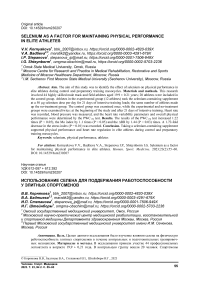Selenium as a factor for maintaining physical performance in elite athletes
Автор: Kornyakova V.V., Badtieva V.A., Stepanova I.P., Shteynborm I.G.
Журнал: Человек. Спорт. Медицина @hsm-susu
Рубрика: Физиология
Статья в выпуске: 2 т.23, 2023 года.
Бесплатный доступ
Aim. The aim of this study was to identify the effect of selenium on physical performance in elite athletes during control and preparatory training mesocycles. Materials and methods. This research involved 44 highly skilled male track and field athletes aged 19.9 ± 0.21 years; 20 athletes were included in the control group. Athletes in the experimental group (12 athletes) took the selenium-containing supplement at a 50 µg selenium dose per day for 21 days of intensive training loads; the same number of athletes made up the no-treatment group. The control group was examined once, while the experimental and no-treatment groups were examined twice: at the beginning of the study and after 21 days of intensive training. Heart rate was recorded, blood pressure was measured, and the heart rate variability parameters and overall physical performance were determined by the PWC170 test. Results. The results of the PWC170 test increased 1.22 times (P
Selenium, physical performance, athletes
Короткий адрес: https://sciup.org/147240964
IDR: 147240964 | DOI: 10.14529/hsm230207
Список литературы Selenium as a factor for maintaining physical performance in elite athletes
- Aubert A.E., Seps B., Beckers F. Heart Rate Variability in Athletes. Sports Medicine, 2003, no. 33 (12), pp. 889–919. DOI: 10.2165/00007256-200333120-00003. PMID: 12974657
- Badtieva V.А., Pavlov V.I., Sharykin А.S. et al. An Overtraining Syndrome as Functional Cardiovascular Disorder Due to Physical Overload. Russian Journal of Cardiology, 2018, no. 23 (6), pp. 180–190. DOI: 10.15829/1560-4071- 2018-6-180-190
- Baevsky R.M., Motylyanskaya R.E. Heart Rate in Athletes. Moscow, Physical Education and Sports Publ., 1986. 143 p.
- Cardoos N. Overtraining Syndrome. Current Sports Medicine Reports, 2015, no. 14 (3), pp. 157–158. DOI: 10.1249/JSR.0000000000000145
- Fernández-Lázaro D., Fernandez-Lazaro C.I., Mielgo-Ayuso J. et al. The Role of Selenium Mineral Trace Element in Exercise: Antioxidant Defense System, Muscle Performance, Hormone Response, and Athletic Performance. A Systematic Review. Nutrients, 2020, no. 12 (6), p. 1790. DOI: 10.3390/nu12061790
- Flatt A.A., Esco M.R., Nakamura F.Y., Plews D.J. Interpreting Daily Heart Rate Variability Changes in Collegiate Female Soccer Players. The Journal of Sports Medicine and Physical Fitness, 2017, no. 57 (6), pp. 907–915. DOI: 10.23736/S0022-4707.16.06322-2
- Gisselman A.S., Baxter G.D., Wright A. et al. Musculoskeletal Overuse Injuries and Heart Rate Variability: Is there a Link? Medical Hypotheses, 2016, no. 87, pp. 1–7. DOI: 10.1016/j.mehy.2015.12.003. PMID: 26826630
- Harty P.S., Cottet M.L., Malloy J.K., Kerksick C.M. Nutritional and Supplementation Strategies to Prevent and Attenuate Exercise-Induced Muscle Damage: a Brief Review. Sports Medicine Open, 2019, no. 5 (1), 1. DOI: 10.1186/s40798-018-0176-6
- Karpman V.L., Belotserkovsky Z.B., Gudkov I.A. Testing in Sports Medicine. Moscow, Physical Education and Sports Publ., 1988. 208 p.
- Kornyakova V.V., Badtieva V.A., Conway V.D. D-Ribose Intake Effectiveness for Improving Swimmer Functionality. Journal Physical Education and Sport, 2021, no. 21 (1), pp. 159–164. DOI: 10.7752/jpes.2021.01022
- Kornyakova V.V., Badtieva V.A., Conway V.D. The Functional Readiness of Athletes from Cyclic Sports. Human. Sport. Medicine, 2020, no. 20 (1), pp. 128–134. DOI: 10.14529/hsm200116
- Kolliari-Turner A., Oliver B., Lima G. et al. Doping Practices in International Weightlifting: Analysis of Sanctioned Athletes/Support Personnel from 2008 to 2019 and Retesting of Samples from the 2008 and 2012 Olympic Games. Sports Medicine – Open, 2021, no. 7 (1), p. 4. DOI: 10.1186/s40798-020-00293-4. PMID: 33415428; PMCID: PMC7790029.
- Makarova G.А. Sports Medicine. Moscow, Soviet Sport Publ., 2003. 480 p.
- Mason S.A., Trewin A.J., Parker L., Wadley G.D. Antioxidant Supplements and Endurance Exercise: Current Evidence and Mechanistic Insights. Redox Biology, 2020, no. 35. DOI: 10.1016/j.redox.2020.101471
- Maynar M., Muñoz D., Alves J. et al. Influence of an Acute Exercise Until Exhaustion on Serum and Urinary Concentrations of Molybdenum, Selenium, and Zinc in Athletes. Biological Trace Element Research, 2018, no. 186, pp. 361–369. DOI: 10.1007/s12011-018-1327-9
- Nakamura F.Y., Pereira L.A., Esco M.R. et al. Intraday and Interday Reliability of Ultra-Short- Term Heart Rate Variability in Rugby Union Players. Journal of Strength and Conditioning Research, 2017, no. 31 (2), pp. 548–551. DOI: 10.1519/JSC.0000000000001514
- Tessier F., Margaritis I., Richard M.J. et al. Selenium and Training Effects on the Glutathione System and Aerobic Performance. Medicine and Science in Sports and Exercise, 1995, no. 27, pр. 390–396. DOI: 10.1249/00005768-199503000-00015
- Tutelyan V.A., Samsonov M.A., Kaganov B.S. et al. Card Index of Dietary (Therapeutic and Preventive) Nutrition of Optimized Composition. Moscow, National Association of Clinical Nutrition Publ., 2008. 448 р.
- Varlamova E.G. Microelement Selenium: Unique Properties Found in Nature, Key Functions of Selenium-Containing Compounds, Role in Health. Moscow, Rusains Publ., 2021. 88 р.
- Varlamova E.G., Maltseva V.N. Micronutrient Selenium: Uniqueness and Vital Functions. Biophysics, 2019, no. 64 (4), pр. 510–521. DOI: 10.1134/S0006350919040213


